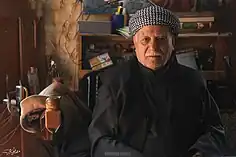Shabandar Café
The Shabandar Café (Arabic: مقهى الشابندر, romanized: Maqha al-Shabander) is one of the oldest and most famous cafés in Baghdad, Iraq. It is located at the end of al-Mutanabbi Street near the Qushla. The café building was previously "al-Shabandar Press", which was established in 1907 and was owned by Musa al-Shabandar, who became Minister of Foreign Affairs at the time of the King Faisal II in 1941. The café is now a cultural and intellectual social hub and is considered one of the most important heritage landmarks of Baghdad where poetry, politics, culture, literature, and art are discussed and a place to increase one's knowledge about said topics.[1][2][3]
| Shabandar Café مقهى الشابندر | |
|---|---|
 | |
| Restaurant information | |
| Established | 1917 |
| Owner(s) | Muhammad al-Khashali |
| City | Baghdad |
| Country | Iraq |
Etymology
The Shabandar Café was named after its owners from al-Shabandar family, a Baghdadi family known for their wealth, prestige, and their work in the field of trade and politics.[4]
Historical background
Establishment and cultural role

The current owner of the café, Muhammad al-Khashali, said that the café was established in 1917, but the building used to be a printing press called "Al-Shabandar Press" owned by Musa al-Shabandar, as this building was previously a printing house for printing books. A controversy then caused Musa to be exiled from Iraq for a few years and when he returned, he began to restore what was left of the building. Musa reinvented it as a café, offered it for rent. The café started to receive customers in 1917, and started to hold concerts for Iraqi maqam, the proceeds of which were returned to charity in Baghdad.[1][5] The café was also a gathering ground and a cultural station for various writers, poets, writers, intellectuals and personalities including political ones such as Nuri al-Said and Abd al-Karim Qasim, due to its proximity to government institutions in the country. The Café also became a gathering ground where political demonstrations were launched such as a demonstration against the Anglo-Iraqi Treaty in 1948.[3][6]
Modern history and restoration
In March 2007, in the wake of sectarian violence in the country following the US invasion of Iraq in 2003, the Shabandar Café was a victim to a bombing from a booby-trapped car situated on al-Mutanabbi Street which killed more than a hundred people. As a result of the horrific explosion, the café was completely destroyed along with its library. In this incident, four of al-Khashali's sons and a grandson of his were killed and found among the rubble and under the rubble. This accident also caused their mother to lose her sight due to the shock, then she died several months later. At the time, al-Khashali was thought to have also been killed but was on a break, and upon hearing the news, al-Khashali was heartbroken and had to control his anger. Al-Khashali made it his goal to keep the café as a center of cultural attraction and to preserve its cultural features and its old identity. As a result, the café was rebuilt, with funding from the state, merchants, and its customers.[7][6][3] The Café has also gained a new name after this, "The Martyrs Café."[8]
The Shabandar Café remains active and still maintains its external appearance, after restoration and renovation. Its walls are also covered with pictures, testimonies, and newspaper clippings which include various aspects of Iraqi society and history. It remains a social club for merchants, employees, writers and foreign tourists. It is also a place where personal interviews are done by Iraqi media.[9][6]
Description and architectural features


The Shabandar Café is characterized by the original Baghdadi architectural style that it contains; the café shows off one of the rare examples of authentic Baghdadi architecture that still stands today. Its building is built of bricks, plaster and gypsum. Given the grandeur of the building and its uniqueness in terms of design and engineering in which Iraqi architecture excelled, it is considered one of the most important archeological sites in Baghdad that is still standing. Al-Khashali explained that he wanted to distance himself from the commercial mentality to preserve its old atmosphere, including the use of old wooden seats and old samovars that are still being used inside.[8][9][10]
The café's interior walls on the first ground floor are decorated with old photographs dating back to Baghdad during the 19th century and the early 20th century including pictures of Ottoman pashas such as Halil Kut and pictures of other Iraqi personalities such as King Faisal I, King Faisal II, Royal Era ministers and Iraqi poets and artists and even foreign celebrities such as Umm Kulthum. The café serves lemon tea brewed the traditional Baghdadi way and the hookah. Unlike many cafés in Iraq, games such as dominoes and backgammon were banned in the café to give space for dialogue and cultural exchanges. The café also includes two floors, the upper floor includes the old offices of the newspaper printing that predate the 1930s.[9][8][10]
References
- "مقهى الشابندر.. شاي عراقي وأحاديث في الثقافة | الحرة". www.alhurra.com (in Arabic). Retrieved 2023-06-14.
- "جريدة الجريدة – الشابندر .. علامة (المتنبي) وآخر محطات عالم الكتب". Archived from the original on 2016-04-13.
- "مقهى الشابندر فضاء عريق للثقافة والأدب ببغداد". www.aljazeera.net (in Arabic). Retrieved 2023-06-14.
- "الگاردينيا – مجلة ثقافية عامة – بغداديات..مقهى الشابندر في بغداد". Archived from the original on 2017-12-07.
- "مقهى الشابندر.. حكاية الأمس واليوم". 2016-11-13. Archived from the original on 2016-11-13. Retrieved 2023-06-14.
- "قبلة لكبار الشخصيات في العراق..ذاكرة 100 عام لمقهى "الشابندر" ببغداد". CNN Arabic (in Arabic). 2020-01-27. Retrieved 2023-06-14.
- "مقهى (الشابندر).. البيت الثقافي في بغداد « كهرمانة نيوز". 2017-06-06. Archived from the original on 2017-06-06. Retrieved 2023-06-14.
- Al-awsat, Asharq. "Middle-east Arab News Opinion". eng-archive.aawsat.com (in Ukrainian). Retrieved 2023-06-15.
- "مقهى الشابندر في بغداد". www.almadasupplements.com. Retrieved 2023-06-14.
- "The changing world of Baghdad's cultural cafés | Oumayma Omar". AW. Retrieved 2023-06-14.